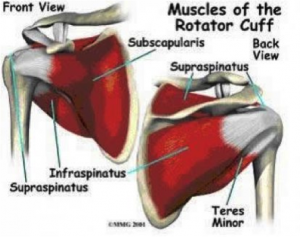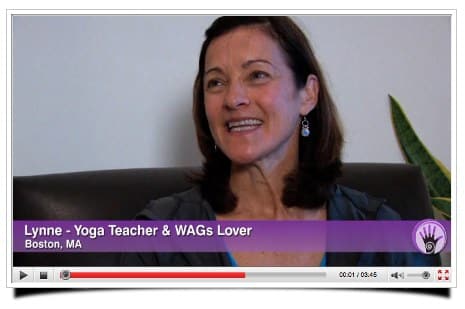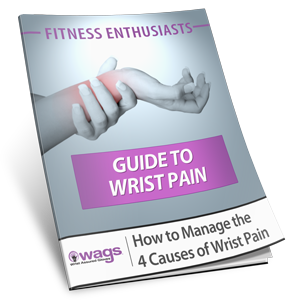The Shoulder and Rotator Cuff Injuries

If you’ve had a shoulder injury then you know how slow they can be to heal. For months now, I’ve been sidelined from my favorite activities with a shoulder injury. What started as a nagging pain in my left shoulder ended up as an extremely painful ‘frozen shoulder’ with bursitis and 2 frayed rotator cuff tendons.
Shoulder injuries often creep up on you and aren’t always traced to a specific incident. For me it was a series of stresses – an overhead snatch move with Kettle Bells, a yoga class with too many sun salutations, pulling a very heavy suitcase and then the final blow was a slip on the ice landing with impact to my wrist, elbow and shoulder.
OVERVIEW OF SHOULDER ANATOMY
The shoulder is a shallow, mobile joint structure that enables multiples planes of movement so we can perform a wide variety of actions with our arms. But we also need stability from our shoulders to pull, push, lift and carry. The compromise of stability for mobility is why the shoulder is more prone to problems and injuries than other deep, stable joints like the hip. The shoulder joint has been described as golf ball (head of the humerus) sitting on a golf tee (glenoid fossa) –which is not very stable!
The Rotator Cuff:
The rotator cuff is a group of flat tendons (tendons connect muscle to bone) which fuse together and surround the front, back, and top of the shoulder joint like a sleeve cuff. These 4 muscles originate on the scapula (shoulder blade) and insert on the humerus (upper arm bone) so that when they contract the pull on the rotator cuff tendon causes an inward, outward or upward rotation -thus the name “rotator cuff”.
The rotator cuff muscles are important in shoulder movements and joint stability by holding the head of the arm bone in the small shallow socket. They act as an assist to the larger shoulder muscles such as the deltoid in the action of raising the arm out to the side.
Common Causes of Shoulder Pain:
The flexibility of the shoulder, combined with it’s strength and power, makes the shoulder vulnerable to strains and overstretching from raised arm or reaching activities.
Overloading the shoulder occurs with postural or positional stresses such as prolonged overhead work or repeatedly raising the arm. Poor posture over time also causes overstretching of the joint structures. These are less severe strains repeated over time but are often the cause of shoulder pain.
Injury and overstretching may also be caused by a sudden severe force placed on the shoulder. Examples include falling onto the shoulder, elbow or hand, and forceful swinging, yanking or pulling motions. These are sudden and unexpected stresses to the shoulder joint that cause overstretching and tissue damage, generally to the rotator cuff tendons.
Rotator Cuff Impingement:
The top tendon of the rotator cuff, the supraspinatus tendon, passes beneath the bone on the top of the shoulder (the acromion). If the space between the undersurface of the acromion and the top of the arm bone (humeral) head is quite narrow then the rotator cuff tendon and lubricating tissue called the bursa, can be pinched as the arm is raised. The tendons and bursa can become inflamed and swollen, especially with repetitive movement & impingement, and cause chronic impingement syndrome. From first hand experience I can attest that this syndrome is quite painful. You may be predisposed to rotator cuff problems due to the shape of your shoulder bones, if you have a bone spur, if you frequently engage in activities with the arm elevated forward or if you have a muscle imbalance due to injury or weakness.
Rotator Cuff Tears:
When the suprapsinatus tendon and the overlying bursa inflammation compresses the joint space and impingement occurs the rubbing and friction can causes progressive damage to the tendon near the arm bone. In some cases it tears completely away from the bone, in my case my tendon “frayed”.
Rotator cuff tears can also occur from ‘wear and tear’ or through trauma to the shoulder joint. This is an injury sustained commonly by athletes who make repetitive overhead or throwing motions like baseball pitchers, volleyball players, quarterbacks and swimmers, as well as those in professions requiring repeated overhead motions such as painters, orchestral conductors or drummers. In an athletic injury repetitive stress and stretching of the rotator cuff occurs during the follow through phase of the throw or action, often due to weakness or imbalance in the strength of the muscles and supporting ligaments.
Frozen Shoulder:
Adhesive Capsulitis otherwise known as a Frozen Shoulder is an inflammation of the shoulder capsule and the surrounding connective tissue becomes inflamed and stiff, greatly restricting motion. The shoulder capsule thickens, swells, and tightens due to bands of scar tissue that have formed inside the capsule. This painful condition severely restricts shoulder movement and causes great frustration due to the slow recovery time. Pain is usually constant, worse at night, and certain movements or bumps can cause sudden tremendous pain that can last several minutes. The exact cause of the condition is unknown, but it can develop following an injury to the arm, as in my case.
Part Two: The next post will cover the treatment options for shoulder pain, including some very effective alternative treatments, including Gua Sha. Stay tuned…





